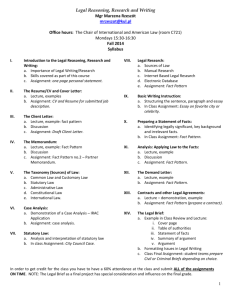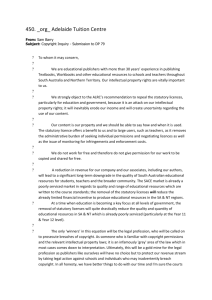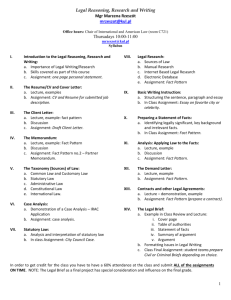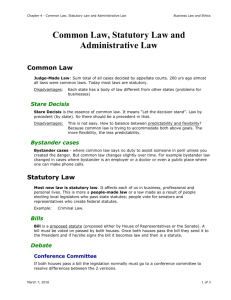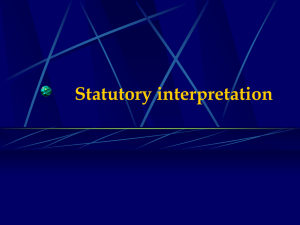law of contract
advertisement
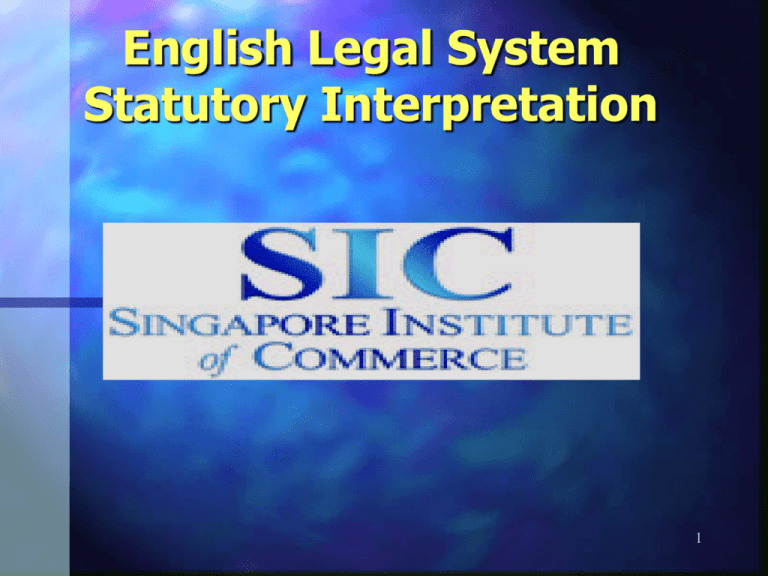
English Legal System Statutory Interpretation 1 Statutory Interpretation Who interprets the Statues? Why? a) Constitutional role of Judiciary is to “apply the Law”. c) Creating Law is the Parliament’s Job Note : The above of course ignores the potential for judicial creativity, in relation to the operation of the common law and judicial precedent & the measure of discretion and creative powere in the manner in which they interpret legislation. 2 Statutory Interpretation Difficulties with Interpretations sometimes arise as a result of the drafting 1) draftsman may refrain from using certain words that he or she regards as implied,.or obvious. 2) draftsman may use broad term..e.g transport - to cover need for generality 3) Ambiguous words may be used 4) There may be unforseeable developments 5) Words may have been left out by mistake 3 Statutory Interpretation Methods of Interpretations 1) Literal Approach (restrictive) : Judges should primarily look at the words of the statues in order to construe the meaning. 2) Purposive Approach (permissive) : Powers to look beyond mere words and to look at the reason for its enactment. 4 Statutory Interpretation Methods of Interpretations 1) Literal Approach (restrictive) English legislation is drafted with the intent that the literal approach would be used. Unlike European legislation. Shah V Barnet London Borough (1983) : The literal approach should be used unless a clear statement of the purpose is mentioned in the statute and reference is made to extrinsic materials. 5 Statutory Interpretation Methods of Interpretations 1) Purposive approach Pickstone V Freemans (1988) HL Its permitted to use the purposive approach especially if European community laws are interpreted and if an English stature has to be referred in the light of European legislation. 6 Statutory Interpretation Rules of Interpretation : Must be done in the light of the Human Right Act 1998.(ECHR) Thus powers of interpretation become wider then usual 1) literal Rule What the legislation actually says (not what it might mean) 2) The golden Rule If application of the literal rule might produce absurd result 3) The Mischief Rule What it intended to correct. 7 Statutory Interpretation Literal Rule : What legislation actually says. Give words in the legislation its literal meaning. Simple words..everyday meaning. Even if it results in an unjust or undesirable outcome. Follow the wishes of parliament ? Literal meaning from dictionary or legal meaning? Fisher V Bell (1961) : The word offer for sale, was interpreted as “offer” in the law of contract. Patridge V Crittenden(1968) : Same interpretation for the word offer in statute 8 Statutory Interpretation Literal Rule : More problems Literal meaning of words ? R V Maginnis (1987) D charged with Misuse of Drugs Act 1971,.,having drugs in possesion”with intent to supply them”. He claimed that since he had intentions to return the drugs to a friend who had left them in his car, he could not be guilty of supplying as charged. H/L : all the lords were looking for the best literal (dictionary) meaning to the word supplying. 9 Statutory Interpretation Golden rule : River Wear Comrs V Adamson(1877) as per Lord Blackburn : “ We are to take the statute and construe it all together giving the words their ordinary signification, unless, when so applied they produce produce an inconsistensy or an absurdity or inconvenience…” 10 Statutory Interpretation Golden rule : 2 versions 1) Narrow meaning : Adler V George (1964) D, charged under the official secrets act 1920, with the obstruction “in the vicinity” of a prohibited area, whereas she had carried out the obstruction “inside the area”. The court decided not to restrict itself to the less absurd meaning and found D guilty. 2) Wider meaning : R V Sigsworth(1935) Only one possible meaning but choose not to accept it. But the court cannot ignore or replace the legislative rule just because it disagrees with the provision. 11 Statutory Interpretation Mischief Rule The most flexible rule : yet the following test to apply: Heydon’s Case (1584) The following must be considered before the mischief rule can be applied to statutory interpretation : 1) What was the common law before the passing of the statue? 2) What was the mischief in the law which the common law did not adequately deal with? 3) What remedy for the mischief had parliament intended to provide? 4) What was the reason for the parliament adopting the remedy? 12 Statutory Interpretation Mischief Rule Heydon’s Case : Look at the purpose of the act. Note : It was the practice at 1584, to cite in the preamble of legislation the purpose for its enactment, including the mischief at which it was aimed. Corkery V Carpenter (1950) A man was found guilty of being drunk in charge of a “carriage” although he was in fact only in charge of a bicycle. Royal College of Nursing V DHSS (1981) Held : medical induction to labour is under the supervision of nursing staff was lawful : It was held that the medical induction of labour by the nurse’s was legally done by a “medical practitioner”. 13 Statutory Interpretation Aids to Construction Secondary aids to construction : 1) intrinsic assistance From the statute itself,…preamble, long title headings,..etc. 14 Statutory Interpretation Aids to Construction 2) Extrinsic assistance Reference to sources outside the Act. E.g. Dictionaries, textbooks, earlier statutes See Interpretation Act 1978 e.g. male refers to female also etc. Bill of Parliament Law commission reports See Pepper V Hart H/L Held : courts could look at Hansard’s report of parliamentary proceedings to look at mischief to be corrected. 15 Statutory Interpretation Aids to Construction Pepper V Hart followed in the case of Three Rivers District Council V Bank of England(1996) : :in short, reference may be made to the Hansard to find out the purpose behind the legislation only if the literal and golden rule cannot be applied. i.e if literally it would be absurd or the statute is ambiguous. 16 Statutory Interpretation Presumptions Notes : The following presumptions may be used in addition to the rules of interpretation. (But presumptions can be rebutted of course) 1) Against the alteration of the common law, unless expressly stated. 2) That a mental element is required for criminal offences. See Sweet V Parsley (1970).HL Premises for smoking cannabis. Dangerous drugs act 1965 3) Against retrospective effect of new law. 4) Presumption against deprivation of liberty 17 Statutory Interpretation Presumptions Cases on mental element presumption : Sweet V Parsley (1970) HL : as per Lord Reid, “ When a section is silent as to mens rea…there is a presumption that we must read in words requiring mens rea” But see : R V Hussain (1981) CA : Held : Possessing of firearm stict liability offence, where mens reas was not required to be proved. R V Brandish (1990) Held: possession of prohibited weapon (canister of CS gas)..was strict liability offence. 18 Statutory Interpretation Against retrospective effect of new law Laws cannot be applied retrospectively. Exception : Statutes may be passed that can do that but it must be specified clearly 19 Statutory Interpretation The War Damage Act 1965 was passed specifically to overrule the decision of the House of Lords in Burmah Oil Co Ltd V The Lord Advocate(1965) Facts : The oil company installations in Burma, which was then a British Colony had been destroyed by the British Forces in 1942, in order to prevent them being captured by Japanese forces. The co. that was registered in Scotland sued the crown for compensation. Held : HL held that the govn should pay. The statute was passed to overrule the House of Lords and to stop the payment of the compensation. 20 Statutory Interpretation The war crimes act 1991 This act allowed the attorney general to authorise criminal proceedings for homicide committed in Germany or German occupied territory during the second world war. The prosecution can be anyone in UK, regardless of nationality at the time of the alleged offence. 21 Statutory Interpretation Presumption that it does not apply to the crown Unless stated clearly the legislation would not apply to the crown Presumption against breaking international law 22 Statutory Interpretation In March 2001, The Law commission of England and Wales, raised the prospect of a second trial of the men accused of murdering the black teenager Stephen Lawrence, by calling the “double Jeopardy” law to be relaxed for murder cases, where there is compelling evidence. So, if the CPS wants to bring fresh prosecutions against the suspects it could do so, if the parliament passes the law. 23 Statutory Interpretation Presumption against deprivation of Liberty The courts interpret statutes on an assumption that it could not have intended to deprive the liberty of anyone unless specifically stated. R v Secretary of State for Home deparment ex p Khawaja (1983) HL Held : The immigration act in the case did not have the effect of placing the burden of proof on an immigrant to show that the decision of the home office to detain him was unjustified. 24 Statutory Interpretation Presumption that words should be interpreted taking their meaning from the context in which they are used : There are three sub rules to the above. noscitur a sociis e.g. a chain of words should be interpreted in relation to each other ejusdem generis e.g horses, cattle, sheep and other animals see Powell v Kempton Park racecourse(1899) expressio unius exclusio alterius If contains list of words, then whatever is not stated,.. is excluded 25
